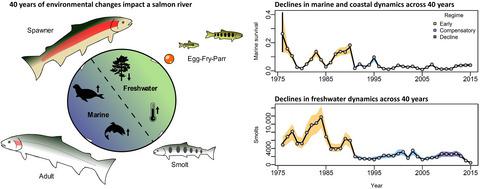当前位置:
X-MOL 学术
›
Glob. Change Biol.
›
论文详情
Our official English website, www.x-mol.net, welcomes your
feedback! (Note: you will need to create a separate account there.)
Marine and freshwater regime changes impact a community of migratory Pacific salmonids in decline
Global Change Biology ( IF 10.8 ) Pub Date : 2021-10-20 , DOI: 10.1111/gcb.15895 Kyle L Wilson 1, 2 , Colin J Bailey 1 , Trevor D Davies 3 , Jonathan W Moore 1
Global Change Biology ( IF 10.8 ) Pub Date : 2021-10-20 , DOI: 10.1111/gcb.15895 Kyle L Wilson 1, 2 , Colin J Bailey 1 , Trevor D Davies 3 , Jonathan W Moore 1
Affiliation

|
Marine and freshwater ecosystems are increasingly at risk of large and cascading changes from multiple human activities (termed “regime shifts”), which can impact population productivity, resilience, and ecosystem structure. Pacific salmon exhibit persistent and large fluctuations in their population dynamics driven by combinations of intrinsic (e.g., density dependence) and extrinsic factors (e.g., ecosystem changes, species interactions). In recent years, many Pacific salmon have declined due to regime shifts but clear understanding of the processes driving these changes remains elusive. Here, we unpacked the role of density dependence, ecosystem trends, and stochasticity on productivity regimes for a community of five anadromous Pacific salmonids (Steelhead, Coho Salmon, Pink Salmon, Dolly Varden, and Coastal Cutthroat Trout) across a rich 40-year time-series. We used a Bayesian multivariate state-space model to examine whether productivity shifts had similarly occurred across the community and explored marine or freshwater changes associated with those shifts. Overall, we identified three productivity regimes: an early regime (1976–1990), a compensatory regime (1991–2009), and a declining regime (since 2010) where large declines were observed for Steelhead, Dolly Varden, and Cutthroat Trout, intermediate declines in Coho and no change in Pink Salmon. These regime changes were associated with multiple cumulative effects across the salmon life cycle. For example, increased seal densities and ocean competition were associated with lower adult marine survival in Steelhead. Watershed logging also intensified over the past 40 years and was associated with (all else equal) ≥97% declines in freshwater productivity for Steelhead, Cutthroat, and Coho. For Steelhead, marine and freshwater dynamics played approximately equal roles in explaining trends in total productivity. Collectively, these changing environments limited juvenile production and lowered future adult returns. These results reveal how changes in freshwater and marine environments can jointly shape population dynamics among ecological communities, like Pacific salmon, with cascading consequences to their resilience.
中文翻译:

海洋和淡水状况的变化影响了太平洋鲑鱼洄游群落的减少
海洋和淡水生态系统越来越面临多种人类活动(称为“政权转变”)带来的大规模连锁变化的风险,这可能会影响人口生产力、恢复力和生态系统结构。太平洋鲑鱼的种群动态表现出持续且巨大的波动,这是由内在因素(例如密度依赖性)和外在因素(例如生态系统变化、物种相互作用)共同驱动的。近年来,由于政权转变,许多太平洋鲑鱼数量减少,但对驱动这些变化的过程的清晰了解仍然难以捉摸。在这里,我们揭示了密度依赖性、生态系统趋势和随机性对五种溯河产卵太平洋鲑科鱼(钢头鲑鱼、银鲑鱼、粉鲑鱼、多莉瓦尔登和沿海切喉鳟鱼)在长达 40 年时间里生产力状况的影响。 -系列。我们使用贝叶斯多元状态空间模型来检查整个社区是否也发生了类似的生产力转变,并探索了与这些转变相关的海洋或淡水变化。总体而言,我们确定了三种生产力状态:早期状态(1976-1990)、补偿状态(1991-2009)和下降状态(自 2010 年以来),其中观察到 Steelhead、Dolly Varden 和 Cutthroat Trout 的大幅下降,中间状态银鲑鱼数量下降,粉红鲑鱼数量没有变化。这些状况的变化与鲑鱼生命周期的多重累积效应有关。例如,海豹密度的增加和海洋竞争与钢头成年海洋生物的存活率降低有关。过去 40 年,流域伐木也加剧,导致 Steelhead、Cutthroat 和 Coho 的淡水生产力下降(其他条件相同)≥97%。对于 Steelhead 来说,海洋和淡水动力学在解释总生产力趋势方面发挥着大致相同的作用。总的来说,这些不断变化的环境限制了幼体的生产并降低了未来成年体的回报。这些结果揭示了淡水和海洋环境的变化如何共同影响太平洋鲑鱼等生态群落的种群动态,对其恢复能力产生连锁影响。
更新日期:2021-12-03
中文翻译:

海洋和淡水状况的变化影响了太平洋鲑鱼洄游群落的减少
海洋和淡水生态系统越来越面临多种人类活动(称为“政权转变”)带来的大规模连锁变化的风险,这可能会影响人口生产力、恢复力和生态系统结构。太平洋鲑鱼的种群动态表现出持续且巨大的波动,这是由内在因素(例如密度依赖性)和外在因素(例如生态系统变化、物种相互作用)共同驱动的。近年来,由于政权转变,许多太平洋鲑鱼数量减少,但对驱动这些变化的过程的清晰了解仍然难以捉摸。在这里,我们揭示了密度依赖性、生态系统趋势和随机性对五种溯河产卵太平洋鲑科鱼(钢头鲑鱼、银鲑鱼、粉鲑鱼、多莉瓦尔登和沿海切喉鳟鱼)在长达 40 年时间里生产力状况的影响。 -系列。我们使用贝叶斯多元状态空间模型来检查整个社区是否也发生了类似的生产力转变,并探索了与这些转变相关的海洋或淡水变化。总体而言,我们确定了三种生产力状态:早期状态(1976-1990)、补偿状态(1991-2009)和下降状态(自 2010 年以来),其中观察到 Steelhead、Dolly Varden 和 Cutthroat Trout 的大幅下降,中间状态银鲑鱼数量下降,粉红鲑鱼数量没有变化。这些状况的变化与鲑鱼生命周期的多重累积效应有关。例如,海豹密度的增加和海洋竞争与钢头成年海洋生物的存活率降低有关。过去 40 年,流域伐木也加剧,导致 Steelhead、Cutthroat 和 Coho 的淡水生产力下降(其他条件相同)≥97%。对于 Steelhead 来说,海洋和淡水动力学在解释总生产力趋势方面发挥着大致相同的作用。总的来说,这些不断变化的环境限制了幼体的生产并降低了未来成年体的回报。这些结果揭示了淡水和海洋环境的变化如何共同影响太平洋鲑鱼等生态群落的种群动态,对其恢复能力产生连锁影响。











































 京公网安备 11010802027423号
京公网安备 11010802027423号